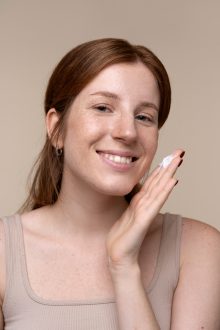- Empty cart.
- Continue Shopping
The Power of Storytelling in Your Skincare Brand’s Marketing
The Power of Storytelling in Your Skincare Brand’s Marketing
In today’s crowded skincare market, storytelling has become a powerful tool to create an emotional connection with customers. By weaving a compelling narrative, your brand can stand out, resonate with consumers, and build lasting relationships. Here’s how storytelling can transform your skincare brand’s marketing.
1. Define Your Brand Story
- Why It Matters: A clear brand story helps customers understand your mission and values, forming an emotional connection.
- How to Do It: Share why your brand was created, the inspiration behind it, and the values that guide it. Highlight the challenges, breakthroughs, or personal experiences that led you to start the brand. Whether it’s a commitment to natural ingredients or a passion for skincare solutions, a strong story makes your brand memorable.
Tip: Keep your story genuine and relatable, showing the real people behind the brand.
2. Showcase Your Ingredients’ Origins
- Why It Matters: Today’s consumers are interested in ingredient transparency and sustainable sourcing, making ingredient storytelling impactful.
- How to Do It: Share the journey of your ingredients—from sourcing to formulation. Describe the regions they come from, ethical sourcing practices, and the benefits they bring to the skin. For example, talk about the journey of a rare botanical extract, its cultural significance, or the benefits it brings to your products.
Tip: Use visuals, like photos of the sourcing process or locations, to enhance the storytelling experience.
3. Highlight Your Brand’s Mission and Values
- Why It Matters: Consumers connect with brands that align with their own beliefs, so sharing your mission builds loyalty.
- How to Do It: Emphasize the values that drive your brand, such as sustainability, cruelty-free practices, or supporting local farmers. Explain how your brand’s mission translates into product development, packaging choices, and customer interactions.
Tip: Reinforce your brand values through social media posts and blog content to reach customers who share similar beliefs.
4. Feature Customer Stories and Testimonials
- Why It Matters: Real customer stories give authenticity to your brand, helping new customers relate to your products and trust your brand.
- How to Do It: Encourage satisfied customers to share their skincare journeys, experiences, and results with your products. Post testimonials, before-and-after photos, or even short videos of customers talking about how your products have benefited them.
Tip: Highlight customer stories in newsletters or on social media to show how your products make a difference in real lives.
5. Share the Product Creation Process
- Why It Matters: Giving customers a behind-the-scenes look at how your products are made builds trust and transparency.
- How to Do It: Share your product development journey, from choosing ingredients to testing and refining formulas. Explain how you ensure quality, safety, and efficacy at every step. This shows the care and expertise that go into each product.
Tip: Use video or photo stories to bring customers into the process, helping them feel connected to your brand on a deeper level.
6. Use Visual Storytelling to Enhance Your Message
- Why It Matters: Visuals make storytelling more engaging and memorable, especially in an industry as visual as skincare.
- How to Do It: Use high-quality images, graphics, and videos to tell your brand’s story. Show your products in real settings, capture the textures, and highlight the ingredients’ natural beauty. Visual storytelling can also help explain complex concepts, like ingredient benefits, in an easily understandable way.
Tip: Create a cohesive visual theme that matches your brand’s identity, whether it’s earthy, luxurious, or minimalistic.
7. Highlight Social and Environmental Impact
- Why It Matters: Customers increasingly look for brands that make a positive impact, so sharing your contributions can boost loyalty.
- How to Do It: Describe how your brand contributes to environmental protection or supports social causes. For example, if you use sustainable packaging or support ethical labor practices, share this story to show how your brand goes beyond skincare.
Tip: Use social media and your website to show measurable impacts, like the amount of plastic saved or local communities supported.
8. Involve Customers in Your Brand Journey
- Why It Matters: Inviting customers to be part of your brand’s journey creates a loyal community and a sense of belonging.
- How to Do It: Share upcoming projects, new product developments, or even challenges your brand faces. Ask for customer input on product ideas, packaging designs, or names. This involvement makes customers feel like valued members of your brand’s journey.
Tip: Use polls, Q&As, and interactive content on social media to invite participation and feedback.
9. Craft Stories Around Your Product Benefits
- Why It Matters: Skincare is personal, and stories that focus on benefits make your products feel more relevant and relatable.
- How to Do It: Share stories about how your products solve specific skincare issues, like dryness, sensitivity, or dullness. Describe a day-in-the-life story of how a customer might use your products to create a beneficial skincare routine.
Tip: Create user guides or “How-to” stories to illustrate product benefits and usage, helping customers see real value.
10. Build Brand Loyalty with Authenticity and Consistency
- Why It Matters: Consistency and authenticity in storytelling help build a trustworthy brand identity.
- How to Do It: Ensure that all brand communications—from product descriptions to social media posts—reflect your brand’s values and story. Avoid exaggerating claims or over-promising; instead, stay genuine and honest in all content.
Tip: Use a consistent voice, whether you’re writing blog posts, social media captions, or customer emails, to create a cohesive brand image.
Key Benefits of Storytelling in Skincare Marketing
- Creates Emotional Connection: Storytelling humanizes your brand, fostering an emotional bond with customers.
- Builds Trust and Credibility: Sharing behind-the-scenes processes and real testimonials boosts transparency and trust.
- Differentiates Your Brand: A unique brand story sets you apart, making your skincare line more memorable.
- Enhances Customer Loyalty: Engaging, authentic stories make customers feel valued, increasing loyalty.
Conclusion: Transforming Your Brand with Powerful Storytelling
Storytelling is more than just marketing—it’s a way to build relationships and create meaningful connections. By crafting authentic, relatable stories around your brand, ingredients, and customers, you can deepen trust, increase brand loyalty, and make a lasting impact in the skincare industry. Whether through visuals, testimonials, or product origins, storytelling brings your brand to life, helping you stand out and succeed.
Interested in creating your own product line? Explore our private labeling options and bring your brand vision to life. Fill out our Form to get started.
Discover more about our services by visiting our website.

